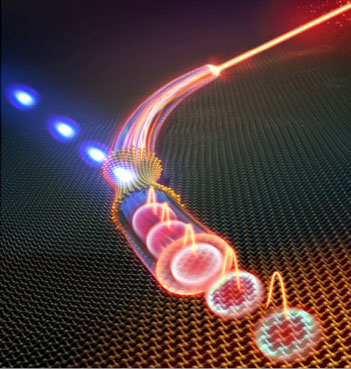| Mar 15, 2019 | |
Antimonene-based all-optical modulator |
|
| (Nanowerk Spotlight) In recent years, all-optical modulators (AOMs) have attracted significant interests due to their low power consumption, broad bandwidth, and potential in all-optical fields. Among these, AOMs based on the high photothermal efficiency of antimonene, exhibit remarkable advantages for their large modulation depth, wide operating wavelength range, and easy implementation. | |
| In new research, led by Professor Han Zhang at Shenzhen University in China, and published in Laser & Photonics Reviews ("An All-Optical, Actively Q-Switched Fiber Laser by an Antimonene-Based Optical Modulator"), researchers demonstrated that the antimonene-based AOM was successfully utilized to actively Q-switch a fiber laser in a fully photonics domain and this actively modulated laser represented all-optically tunable output parameters (e.g., output repetition rate), and easy time synchronization. | |
| In this work, the antimonene nanosheets with a lateral size ranging from 35 to 120 nm and a thickness ranging from 6.7 nm to 14.5 nm, were successfully fabricated by a facile liquid phase exfoliation (LPE) approach. The prepared antimonene nanosheets suspension was dropped onto a home-made 10 µm microfiber and employed into a photothermal-based AOM as a whole. By guiding the control light into antimonene-deposited microfiber, the antimonene nanosheets absorb the control light and generate a large amount of heat due to its excellent photothermal effect. | |
 |
|
| Antimonene nanosheets can be used as an effective photothermal agent with satisfactory photothermal conversion efficacy (48%), possessing great potential in the field of all-optical, actively Q-switched fiber lasers. (Image: Dr. Yunzheng Wang, Dr. Weichun Huang, Shenzhen University) | |
| Assisted by the large photothermal effect of antimonene, an AOM was devised with an all-fiber Michelson interferometer (MI). Thanks to the double-pass structure of MI, the maximum phase shift of 16π was achieved at the highest accessible pump power of 335 mW with a slop efficiency of 0.049π mW-1. For intensity modulation, the antimonene-based AOM possessed a rise time constant of 3.2 ms and was able to be modulated up to 2 kHz. | |
| In addition, the conversion efficiency of phase shift of the fabricated antimonene-based AOM declines only 8.2% and both the interferometric contrast and the free spectral range have no visible change after one month, suggesting that the antimonene-based AOM has excellent long-term stability under ambient conditions, implying that it holds great practical application in the field of black phosphorus analogue nanomaterials-based AOM. | |
| This antimonene-based AOM, for the first time, was proposed and successfully applied for the generation of Q-switched laser pulses as an all-optical active Q-switcher. Compared with conventional active Q-switcher such as bulk-crystal electro-optic modulators and acousto-optic modulators, and recently reported graphene electro-optic modulator, this antimonene-based all-optical active Q-switcher regulates the laser pulse fully in the photonics domain in the absence of external electric signals, providing a viable avenue for achieving Q-switched laser pulse with an all-optical method in the future. | |
| It is anticipated that this actively antimonene-based all-optical modulator with advantages of high conversion efficiency, large modulation depth, low energy consumption and great long-term stability, has promising potential in all-optical information processing and pulsed laser engineering. | |
|
Provided by Shenzhen Engineering Laboratory of Phosphorene and Optoelectronics, Shenzhen University, as a Nanowerk exclusive
|
|
|
Become a Spotlight guest author! Join our large and growing group of guest contributors. Have you just published a scientific paper or have other exciting developments to share with the nanotechnology community? Here is how to publish on nanowerk.com. |
|
